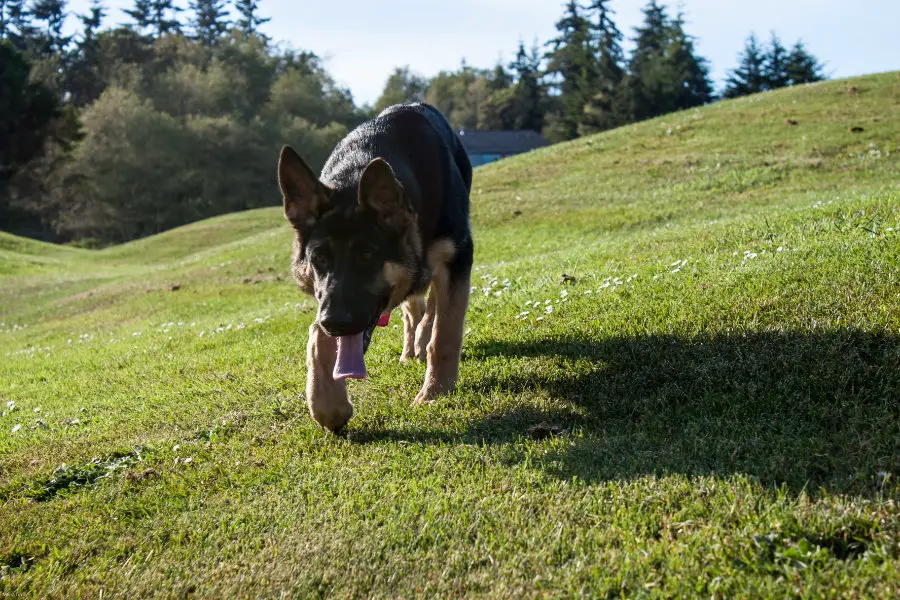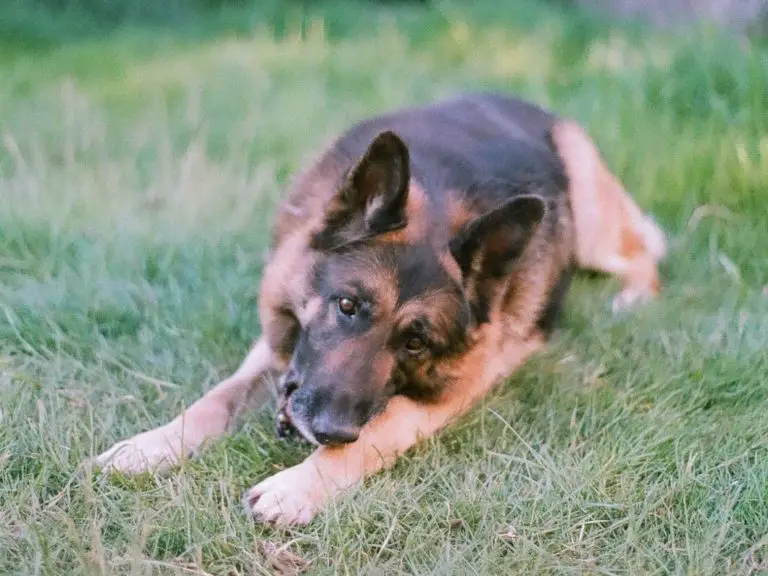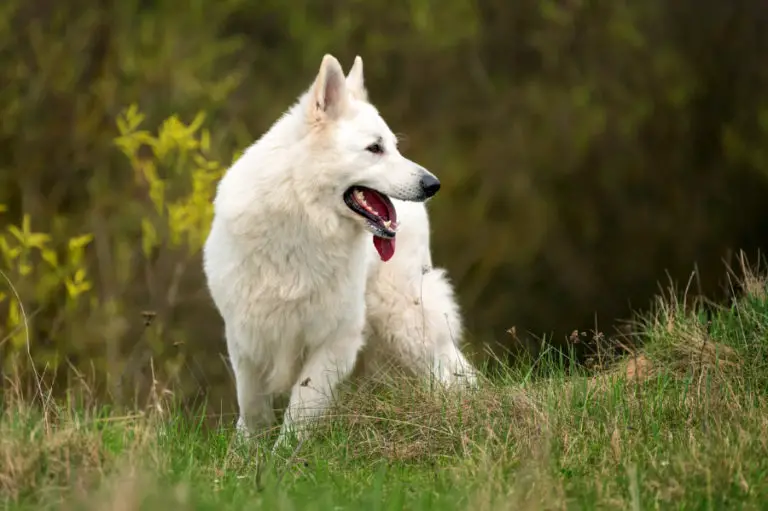Why Your German Shepherd Is Breathing Heavily
Panting is a dog’s natural method of cooling down. Since canines cannot sweat like humans when they’re hot, they use the air circulation through their respiratory system and over their tongue to regulate their temperature. However, new dog owners may wonder how much panting or heavy breathing is too much?
German Shepherds generally pant or breathe heavy because they are hot or excited, which is normal. However, an increased rate of panting or heavy breathing at night or during cooler temperatures may be an indication of health problems like anxiety or heart failure.
If you have noticed your German Shepherd panting more than usual, you may be wondering if this is normal or an indication of a more severe problem. While heavy breathing is more common in younger German Shepherds, all dogs can experience it for several reasons. It is important to understand the common causes of heavy breathing as well as how to identify it and help reduce it.
German Shepherds: Origins Of Heavy Breathing
German Shepherds were initially bred as herding dogs known for their courage, loyalty, and guarding instincts. As such, they can be territorial and even sensitive and nervous to changes in their situation; this may cause them to develop anxiety if not properly trained and thus adopt frequent panting.
Younger German Shepherds may experience this more than adult dogs due to their age and lack of training. However, with patience and time, you can help your pup calm down and put their guardian instincts to good use.
However, anxiety is not the most dangerous cause of heavy breathing in dogs. It is essential to rule out other causes such as heat or illness first.
5 Causes Of Heavy Breathing In German Shepherds
1. Heat or Vigorous Exercise
The most common cause of panting in dogs is if they are hot or have just participated in vigorous exercise. As panting is the only way a dog has to cool down, it is a regular occurrence in the summer. Also, if they have just finished a run or a high-energy play session, they are likely to pant for the same reasons we breathe hard after going to the gym.
The larger or fluffier a dog is, the more they may pant. German Shepherds are good examples of this because their thick coat is designed to keep heat in. If the dog’s panting slows down once the activity has decreased and it gets cooler, then there is nothing to worry about.
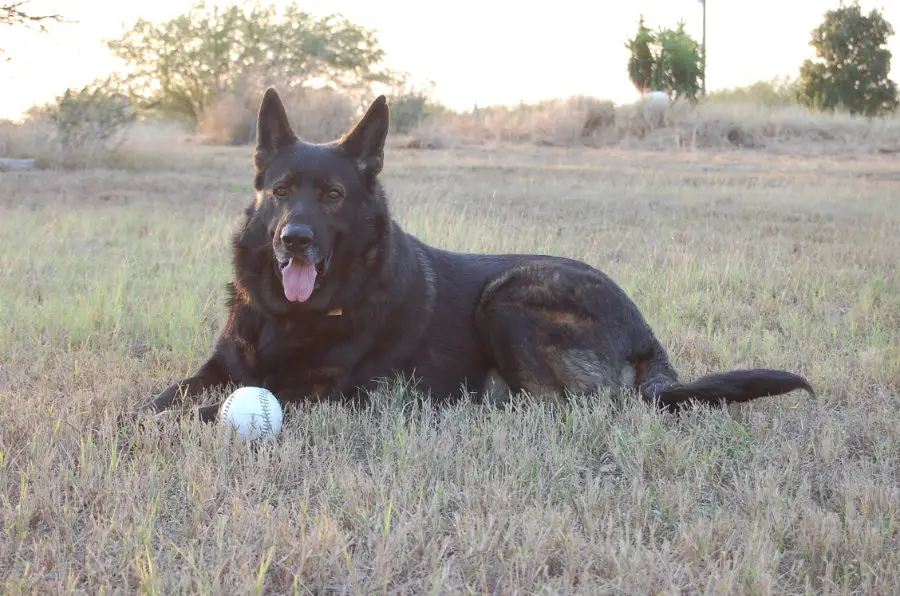
How to Identify Heatstroke in Dogs
The one time you do want to worry about an overheated dog is during cases of heatstroke. Overheating is a medical emergency, whether it is in humans or animals. This sudden, severe cause for panting in dogs can be mitigated by a quick response from the owner, followed by a visit to the vet.
Heatstroke can be caused by heightened physical activity in a hot environment, overexposure to sunlight, and/or too little water or shade. Physical symptoms besides heavy breathing can include:
- Glassy eyes
- Drooling
- Fast heart rate
- Vomiting
- Temperature above 104 degrees Fahrenheit
If you suspect your dog is suffering from heatstroke, call your vet right away. Additionally, following the below treatment steps at the first signs can help cool the dog and provide life-saving care:
Treating Heatstroke in Dogs
The number one way to treat heatstroke is to avoid it in the first place. Monitor your pet’s activity level and water consumption on hot days and try to provide them with a cool or shady place to escape the heat. Never leave your dog in a parked car, because even with the windows cracked, temperatures can get up to 120 degrees Fahrenheit.
For a dog suffering from heatstroke, you want to cool them down slowly. Make sure not to drop their temperature too quickly since that can lead to constricted blood vessels, which can cause a stroke.
Here are some steps you can follow to get the dog’s temperature down:
- Move them to a shaded spot
- Submerge them in cool (not cold) water or place ice packs on their chest, neck, and head.
- Give your dog cool (not cold) water to drink.
- Give him ice cubes to lick.
Note: Be careful not to spray your dog with a water hose; the water left in hoses can heat to almost boiling temperatures.
Once you’ve gotten your dog cool, give the vet a call, nonetheless.
2. Excitement/Anxiety
Another reason your dog is panting could be because they are excited. Much like you get wound up for a big presentation at work or excited to meet a friend, your dog also experiences such emotions. They may be thrilled to see you get home for the day or get worked up when strangers ring your doorbell.
Either way, some amount of panting from excitement is expected; however, if it is frequent or constant, it may mean your dog has a more severe form of anxiety. German Shepherds may be more susceptible to anxiety as they are a hyper-vigilant dog breed. They are protective of their humans and want to be involved in all aspects of life. This mentality can lead to heightened levels of anxiety as the dog feels the need to be ever-alert.
In these cases, it is possible for the owner to calm them in the short term and keep them that way. This can be done with a series of training exercises and some diet changes.
3. Chronic Illness
Some dogs may contract a chronic illness or condition that causes them to breathe more heavily than average. Some of these illnesses are:
- Heart Failure
- Cushing’s Disease
- Respiratory Disorders
- Allergies
In the case of chronic illness, it is crucial to monitor your pet’s breathing rate at home; this can alert you to sudden changes in health and help you know when to call the vet.
Heart Disease or Heart Failure
Heart failure is one of the most common illness that causes panting in dogs and cats. Animals show some of the same symptoms as people when it comes to heart failure, including heavy breathing, coughing, and fatigue. Increases in your pet’s resting or sleeping breathing rate may be a sign that your pet is suffering from heart failure.
Cushing’s Disease
This disease occurs when an animal’s adrenal glands produce too much cortisol. Excessive thirst, hair loss, and a pot-bellied appearance can accompany heavy panting. Treatment can include medication and ACE inhibitors.
Respiratory Disorders
Respiratory disorders can also cause heavy breathing, such as pneumonia, laryngeal paralysis, lung tumors. Contact a vet to rule out any of these dangerous conditions.
Allergies
Dogs can also suffer from allergies, whether seasonal or food/material specific. As allergies affect the respiratory system the same way as humans, your dog may need to breathe more heavily due to a histamine reaction.
Typically allergies cause noisy breathing or wheezing in addition to increased breathing rate. Luckily, though, allergies can be treated with medication or the avoidance of allergic triggers.
4. Injury or Pain
Dogs don’t always outwardly express pain the same way humans do. They also can mask it behind normal-seeming behavior gestures such as tail wagging or panting.
However, as their guardians, it is our job to notice these changes in behavior. Accompanying panting, you may notice restlessness, anxiety, licking or scratching an area excessively, or enlarged pupils. If you’re concerned that your pet is suffering from an unseen injury or pain, contact your vet immediately.
5. Medication
Some medications can cause shortness of breath or excessive panting in dogs. If you suspect a new medication is the issue, consult with your vet about a possible different treatment plan for your dog’s ailments.
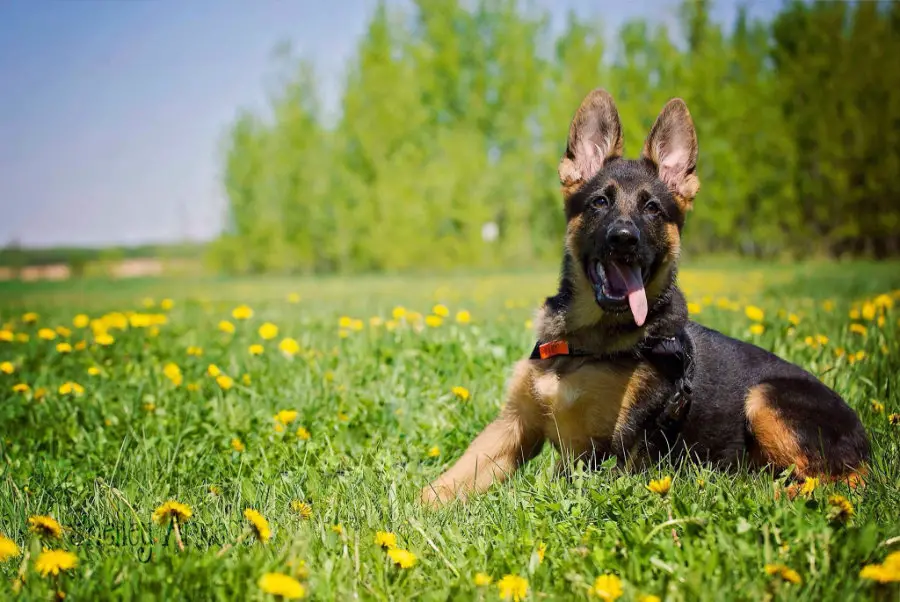
How To Identify Heavy Panting & Breathing
Being able to distinguish normal panting from heavy panting in your dog is vital in monitoring their health and mental state. While it may seem challenging to determine the difference at first, with a little practice, it will become easy.
While this practice is essential for dogs with heart failure or other preexisting conditions, it can also be useful to know for healthy animals, too. This way, you are prepared if an emergency ever arises.
First, you need to recognize your dog’s sleeping or resting breathing patterns. Most dogs take between 15-30 breaths per minute, though some can be lower, which is generally not a cause for concern. Higher than 30 breaths per minute is normal if the dog is hot or winded but should not be a sustained rate.
Measuring Your Dog’s Breathing Patterns
To measure your dog’s breathing patterns, it’s best if you can do it while they’re sleeping since this rate is usually slightly lower than just resting. However, if they are calm and resting, this works as well.
One breath consists of both a rise and a fall in chest movement, which is an indication of an inhale and exhale. Use a stopwatch, phone, or another timepiece to measure 30 seconds as you count the breaths. Then, multiply that number by two and you’ll know how many breaths per minute your pet is experiencing.
If you are counting the breaths of a healthy animal, do this once per day so you can establish a baseline. Make sure to record the results every day in a notebook or on your calendar/phone. If your pet is ill or experiencing heart failure, your vet may recommend monitoring this every hour.
There are also devices that can help you monitor your dog’s breathing like Voyce, though it’s recommended to do manual counts also.
What to Do if Your Dog’s Breathing Rate Increases
Once you have determined that your German Shepherd’s breathing rate has risen (by checking every hour or day and coming up with a consistent finding), you’ll want to contact your veterinarian right away to discuss the next steps. This is especially the case if your dog shows other signs of hyperventilation, such as:
- Rapid heart rate
- Blue gums
- Collapsing or fainting
- Weakness
If this is related to a physical health issue, the vet may recommend making an appointment or emergency visit. If the panting is determined to be due to stress or anxiety, your vet may offer recommendations on how to calm your dog.
How To Calm Panting In Anxious Dogs
Dogs, like people, can get stressed, nervous, or anxious in unfamiliar situations or due to changes in routine. Some dogs are extra sensitive, and even one small thing being out of place (like a squirrel running around in the yard) can cause them to get worked up.
When dogs get worked up in such fashion, it could cause them to pant heavily and often. Fortunately for both dog and owner, it’s possible to undergo focused training to teach your dog about a life of Zen. In doing this, the owner should also remain calm so their buddy can pick up on it.
In training your dog to adopt calmness, positive reinforcement is the key; this comes primarily in the form of treats but also affirmations of good behavior work as well. Just ensure your affirmations are not too enthusiastic because that could cause excitement in the dog, thus counteracting your recent training session.
Treats
When choosing treats for your enthusiastic dog, it’s recommended you find soft or lickable treats. Some dogs find chewing, crunching, and chasing to be excitable activities and overstimulating when they’re trying to learn to be calm. Yogurt in a squeeze bottle, shredded chicken, or the soft sausage-rolled dog treats are some options you can try.
You can also use finding treats as a distraction from whatever is upsetting your pooch. Sniffing is a natural calming action for dogs as it allows their focus to be on something tangible. It also dedicates breaths to the sniff, which can alleviate panting.
To do this, take a handful of a treat or a single piece, and “hide” it in the grass or ground below your dog. If they need encouragement, look with them, and point out the tasty treats.
Practice Calming Behaviors
As an owner, taking your own deep breaths can help show the dog that calm is okay. You want to encourage your dog once they stop panting, even for a moment, and provide them with a treat. Gradually, you’ll increase the time they need to not be panting to get a reward. You can also accompany this behavior with a softly stated “yes.”
Another way to help your dog chill out is by having them place their chin in your hand. Use treats and a flat, upturned palm to slowly encourage your dog to move their chin closer to your hand. Accompany this, again, with a soft “yes.” Eventually, your dog will not need treat encouragement but will derive comfort from placing their chin on your palm.
Using a mat or towel as a “calm place” also helps the dog feel like they have a relaxed space of their own. Spark their interest in the mat with treats and affirmations without telling the dog to go to the mat. Since it is supposed to be a refuge for your dog, you want it to be their idea when they goes there.
Make sure to accompany this coaxing with a release cue like “free dog” so they know when they can leave. At first, the mat will only be out as a special treat and hidden the rest of the time. Eventually, you can leave the mat out all the time and quietly reward your pet for lying on the mat on their own.
Catch Your Dog Resting
The best thing you can do to encourage your German Shepherd to stay calm is to catch them in their ever-elusive “rest” pose. If you see your dog sleeping or relaxing, quietly place a treat nearby without saying anything. This is the time where enthusiastic praise could actually be a detriment because it will get the pup wound up again. This technique is called “capturing calmness.”
There are many reasons why your German Shepherd may be breathing heavily, but some are definitely more dangerous than others. It’s essential to take the situation into account before panicking, but also seeking veterinarian care if necessary.
As your pet’s guardian, there are also a lot of things you can do to help your dog in a stressful, health- or heat-induced situation. Always call your vet if you are unsure if care is needed.
Sources:
RSPCA.org.uk
TodaysVeterinaryPractice.com
